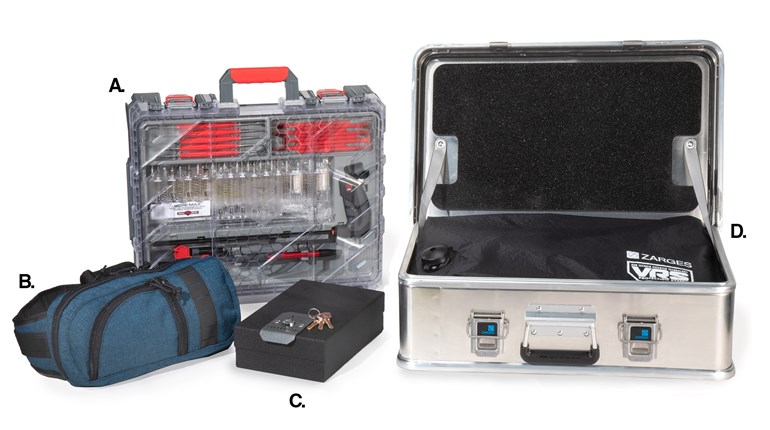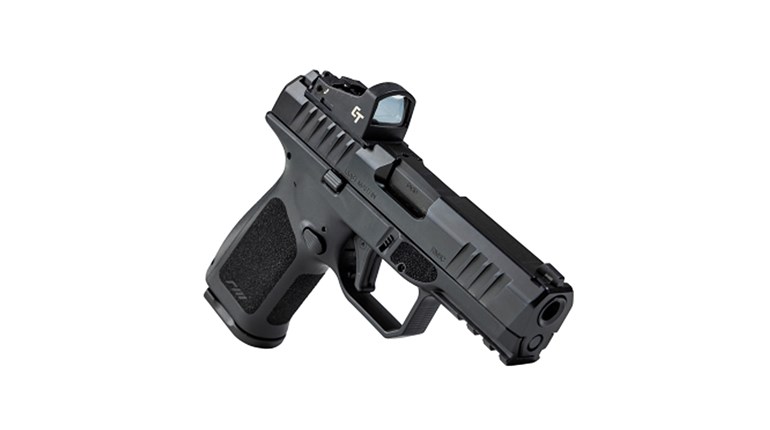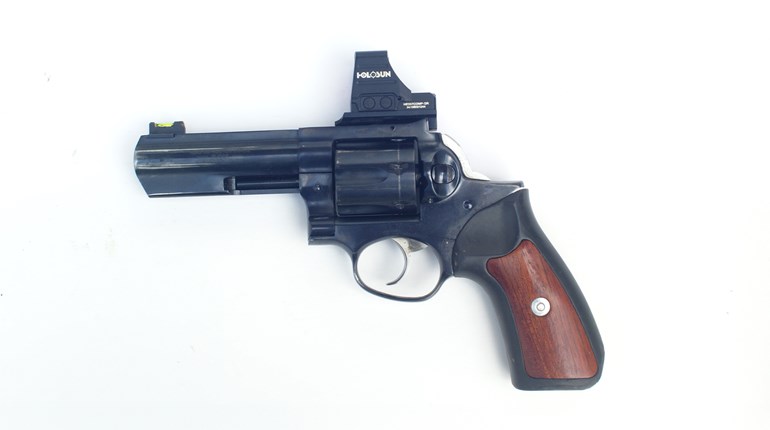
Crimson Trace
If you’ve carried a defensive firearm long at all, you’ve likely encountered a Crimson Trace product. For more than 20 years, the company has been providing laser-based sighting and lighting systems for just about anything with an accessory or Picatinney rail, and for many firearms without, too.
In a word—mighty good stuff. (Ok, that’s three words.) In a firing grip, you’ll (easily) activate the laser, and a dot will appear on your target as long as that grip is maintained.
A recent arrival on our doorstep is their model “Laserguard"® LG-443, a trigger-guard mounted laser for the Glock G42 (.380 ACP) and G43 (9mm) pistols. While this mounting technique has been around for some time (and we’ve done more than a few), we have to observe that the Crimson Trace execution makes the whole process a cakewalk. Taking our time to try and discern any changes, we were still ready to go in about 10 minutes. The molded halves fit snugly from the front of the grip to the end of the frame, press-fitting with precise ease on the contours of the trigger guard. With a battery placed in the operative right half (polarity well-marked), the covering left half fits into a self-aligning notch. Gentle pressure and two hex-head screws pull the pieces neatly together. A seriously “mini” hex is provided for the job, so another potential grumble is avoided.
Our unit—in a nice confidence-builder regarding the quality of the LG-443—was virtually spot-on without any adjustment of the laser once the halves were joined. Using that same included hex, getting alignment to match our iron sights took another (very) few minutes. Activating the laser when you wish to shoot is the easiest thing of all, as there’s a button right under your middle finger. In a firing grip, you’ll (easily) activate the laser, and a dot will appear on your target as long as that grip is maintained with either hand.
Range performance on our G42 was typical Crimson Trace—superb.
A couple of details—all to the good—and a caution remain. As we wrote in this week’s Carry Life, tech like the Crimson Trace can undo a lot of careful testing and matching of carry “kit”—a real nuisance and potential expense. For a goodly number, however, CTC and Blade-Tech have teamed up to make this a non-issue by including an adjustable Kydex ambidextrous holster with the LG-443. Range performance on our G42 was typical Crimson Trace—superb.
The holster itself looks to be vanilla, but it’s a clever wolf in sheep’s clothing. The provided bracket produces not only the desirable lefty or righty functionality, but also gives a very useful range of depth adjustment without compromising very positive belt lock-up (to 1 ¾” belt widths). While CTC and Blade-Tech call this an “IWB” holster (inside the waistband), we found it perfectly configurable for OWB, and it looks as though Appendix carry will even work for some body shapes. Nicely played, sir(s)!
Our promised caution isn’t a negative, and doesn’t relate only to Crimson Trace products, but rather to “designation” sight technologies in general—those that project an actual dot on a prospective target. This variation is typically encountered more in rifle shooting rather than close-range pistol, but we see folks struggle with it nonetheless: parallax. It’s easiest to think of this as the difference in apparent position of the laser aiming point vs. iron sight aiming point, complicated by the notion of ballistic arc—the gravity-induced, curved path of bullet flight relative the straight path we optically see, and which any laser (like the LG-443) appears to describe.
Boiled down, though, the implications are actually pretty simple: Because the laser is mounted below the barrel and the bullet is always falling after it exits the barrel, the actual intersection of the bullet path (curved downward) with the laser’s path (straight) can only occur at one point, and at one fixed distance. If you adjust your Crimson Trace to intersect the line of sight of your conventional (iron) sights on a close target/surface, shots at longer distances will appear to miss on the low side of the laser’s designation. If you adjust the laser and bullet path to meet on a relatively distant object, shots on closer targets will appear to be too high. (Note that the offset of the laser below the barrel by about an inch and a quarter means very close shots will always strike low, no matter the adjustment.)
The point is that nothing is wrong with your Crimson Trace, your pistol or you if shots don’t strike exactly at the point that wiggly laser dot seems to indicate. Making the two match up is a function of steady hands (more practice?), proper adjustment (read your manual/go here!) and not obsessing over the slight variations that are dictated by those Euclid and Newton guys.
The Crimson Trace LG-443 is currently available directly from Crimson Trace at $199. Visit Crimson Trace at http://www.crimsontrace.com/.
Burris FastFire III
Our Burris and Crimson Trace products don’t find themselves paired in First Gear by accident. They represent two very different—but excellent, when correctly applied—technologies that many shooters still confuse: designation (or illumination) and projection (or reflex) sights.

Our Crimson Trace actually puts a laser dot on anything you aim at, and in this sense is the simpler technology. Superb in its own way, it has strengths (and a very few weaknesses) somewhat beyond our scope. Our Burris FastFire is a projection or reflex-type sighting device, which creates the appearance of a dot on the same visual plane as the target by means of reflecting a light source to the location of the shot. It has different strengths, and a few (again, mostly trivial) weaknesses that are technical in nature, too. But as we said, properly applied, both are, well, fabulous. At least in our book.
If that seems a spoiler vis á vis our Burris, you stop reading at your own peril: The FastFire III is enough better than predecessors that it’s worth hanging in there for a couple hundred more words. We promise.
For starters, the versatility of a FastFire is just about unmatched. We use them on both pistols and rifles, and they are essentially cheating when mounted on a shotgun. Available in two dot sizes (3 and 8 MOA—that is 3.14 and 8.37 inches at 100 yards, respectively), you can tune your choice to the firearm and shooting task at hand. As a general rule, the smaller dot is better for distance (like a centerfire rifle), and the larger dot better for handguns and shotguns. But the 8 is great for CQB rifle; just sayin’. For centerfire rifle applications, remember there’s no magnification: What you see is what you get.
Compared to some competitors, the Burris adds a little weight with a glass lens, but you’ll hardly notice as it’s barely an ounce. Pressed, we think glass lens are more scratch-resistant over time, and a little less finicky to get clean. The anodized aluminum body has been slow to show any wear. It’s light and tough, and yes, waterproof.
Brightness is a selectable or auto-adjusted function, all from a switch with a full-off position. While we couldn’t find a published shock rating, we can tell you a Glock G40 10mm with full power ammo (700-plus ft-lbs.) didn’t make it twitch, nor did a “Scout” mount on a .308 bolt gun. A Picatinney adapter for the latter was included from Burris. On the former it was only about five minutes to “bang” with Glock’s provided plate—a perfect fit to the bottom of the FastFire III.
But the runaway favorite feature for us is the ability to change batteries without demounting the sight. An easily accessed, slotted rotary cover is all there is to it. Stick a couple of CR1632s in your bag, and any smallish driver blade (though our multi-tool worked fine, carefully wielded), and you’re good to go for years. We use them on both pistols and rifles, and they are essentially cheating when mounted on a shotgun.
We wrap up with a couple of reminders about reflex sights in general, as many shooters don’t understand the advantage of the likes of a FastFire III. In the main, this is because the benefits don’t correspond to anything that’s as readily discernable in comparisons of other sighting technologies—a top shelf “tube” scope to a foreign knock-off, say, or black-on-black factory pistol sights to Trijicon HDs.
The advantages are two-fold. First, reflex sights should be used with your distance vision prescription or correction, however achieved—glasses, surgery or contacts. If the FastFire dot looks at all fuzzy, that’s on you (though a corona or halo means you may have it set too bright—not a vision issue). Second, don’t waste time trying to center a reflex sight’s dot in the “window” or frame of the sight. Even badly off center, if the dot is on your target, initiate! Bypassing the need for delicate alignment is what makes reflex sights so dazzlingly fast, and the darlings of so many competition, military and law enforcement shooters when speed counts.
Get one, we advise. Once figured out, we’ll be astonished if you can limit yourself to one.
The MSRP of the Burris FastFire III is $299. Visit Burris at http://www.burrisoptics.com/.


































